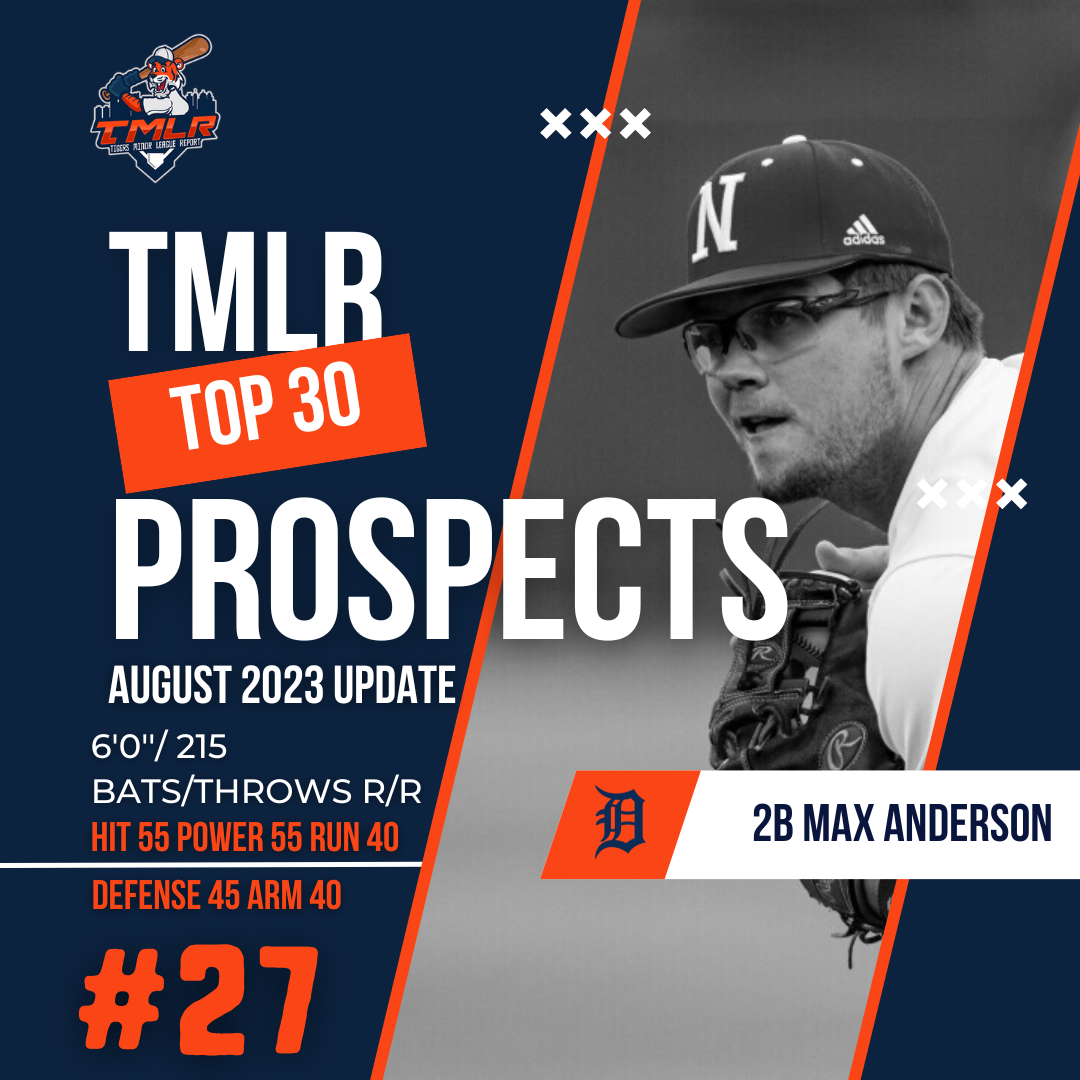Background and Physical Description: Max Anderson had a strong three-year career at Nebraska during which he slashed .350/.400/.604 and earned a variety of accolades, including being named to the Big 10 All-Conference Team multiple times. Anderson also impressed over two summers in in the Cape Cod League, batting .300 and producing a .764 OPS over 72 games. The Tigers selected the right-handed hitter in the second round of the 2023 MLB draft. Anderson is listed at 6’0, 215 pounds, with a huskier physique and fringy athleticism.
Hit-55
A simple setup and load leads to a swing that is geared for spraying the ball all around the yard. Anderson made more than enough contact over his college career posting an 11% strikeout rate.
Power-55
Anderson possesses plus raw power, though it plays more like above-average power in games because of his gap-to-gap approach. He could hit 20–25 home runs at his peak, and supplement that with plenty of doubles.
Run-40
Anderson shows below-average home-to-first times. His lack of athleticism could hinder his defensive utility in the future.
Field- 45
Anderson is a capable fielder when he has the opportunity to make plays, but his lack of agility and arm strength limit him in the field. He’ll have to work to stick at second base, and could find himself in left field or at first base in the future.
Arm-40
Anderson’s below average arm kept him on the right side of the infield in college. He has enough arm strength to make the standard throws at second base, and he’s solid at turning double plays.
Max Anderson – 2025 Scouting Report Update (by Rogelio Castillo)
Background and Physical Description:
Max Anderson continues to showcase the offensive ability that made him a standout at Nebraska. Since being drafted by the Tigers in the second round of the 2023 MLB Draft, he has steadily progressed through the system, displaying a high-contact approach and emerging power. Anderson had a strong first full season in pro ball, posting solid batting averages and power numbers while maintaining a disciplined plate approach.
Physically, he remains a stocky, strong-bodied player at 6’0″, 215 pounds, with fringy athleticism and limited mobility. His bat is still his carrying tool, but questions about his defensive future remain.
Hit: 55 → 55
Anderson’s bat-to-ball skills remain strong, with a high-contact rate and an approach built for all-fields hitting. His strikeout rate has remained low, reinforcing his ability to put the ball in play consistently. However, he has shown some struggles against higher velocity and elite breaking stuff, which could be a concern at higher levels.
Power: 55 → 50
His raw power is still plus, but it continues to play closer to average in games due to his line-drive approach. The power numbers have ticked up slightly, with Anderson flashing 20-25 home run potential as he learns to elevate more pitches. He remains a doubles machine, with solid gap-to-gap power that could allow him to slug at an above-average clip.
Run: 40 → 35
Anderson’s speed has regressed slightly, as expected, and he is now a below-average runner. He won’t be a stolen base threat and has shown limited range defensively due to his lack of quickness.
Defense: 45 → 40
Anderson has struggled to stick at second base, with limited range and athleticism impacting his ability to make plays. While his hands are fine, his lack of lateral quickness has become more evident against better competition. A move to first base or left field is becoming more likely, as his defensive limitations may not hold up at second base long-term.
Arm: 40 → 40
His below-average arm strength is still a concern, and it further limits his positional flexibility. He can make routine throws at second base but lacks the arm strength for third base or deep throws from the outfield. If he moves to first base, his arm will be a non-factor.
Overall:
Anderson continues to show why his bat was highly regarded, as he has proven to be a consistent contact hitter with power that plays in games. However, his defensive shortcomings are becoming more apparent, making it likely that he moves off second base sooner rather than later. If he taps into more loft and elevates the ball, he could become a strong offensive contributor at first base or left field.
ETA: 2026
Ceiling: Above-average everyday hitter with 20+ HR potential, likely at 1B/LF.
Floor: Platoon bat or DH option if defensive limitations force him into a more limited role.

